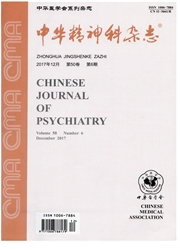

 中文摘要:
中文摘要:
目的探讨色氨酸羟化酶(TPHl)基因A218C多态性对抑郁症患者额叶亚区结构、功能的影响。方法对60例抑郁症患者(患者组)及52名性别、年龄、受教育年限匹配的健康人(对照组)进行磁共振扫描、TPHl基因分型,比较不同诊断组、基因型组内额叶密度、激活强度的差异。结果(1)AA基因型患者组右额下回灰质密度值(1.25±0.03;n=6)较cc基因型对照组(1.37±0.10;n=13)显著降低,差异有统计学意义(F=2.01,P=0.19;经LSD比较,P=0.04)。(2)负性面部表情识别时,AA基因型患者组左额下回(0.19±0.31;n=5)激活强度值较AC基因型患者组(-0.03±0.34;n=13)、CC基因型患者组(-0.11±0.46;n=8)、AC基因型对照组(-0.03±0.23;n=18)、CC基因型对照组(-0.07±0.26;n=10)均显著增强,差异均有统计学意义(F=4.47,P=0.00;经LSD比较,P分别=0.02,0.03,0.02,0.00);AA基因型对照组左额下回(0.15±0.15,n=6)激活强度值较AC基因型对照组、CC基因型对照组均显著增强,差异均有统计学意义(F=4.47,P=0.00;经LSD比较,P分别:0.02,0.02)。同时,AA基因型患者组右额下回(0.33±0.27)激活强度值较其余5组(0.10±0.43;-0.04±0.25;0.05±0.16;0.02±0.28;-0.12±0.31)均显著增强,差异均有统计学意义(F=4.23,P=0.03;经LSD比较;P分别=0.04,0.02,0.04,0.03,0.02)。结论TPHlA等位基因对抑郁症患者额叶亚区功能有一定程度的损害作用,可能构成抑郁症额叶异常的部分遗传学基础。
 英文摘要:
英文摘要:
Objective To explore the relationships of a polymorphism (A218C) of tryptophan hydroxylase 1 gene and structure and functional states of frontal suhregions in patients with major depressive disorder. Methods Sixty depressed patients and 52 healthy controls underwent magnetic resonance imaging and genotyping to compare the difference between different diagnosis and genotype groups. Results ( 1 ) Gray matter concentration (GMC) of the fight inferior frontal gyms reduced significantly only in patients with AA genotype ( 1.25±0. 03, n = 6) than in controls with CC genotype ( 1.37± 0. 10, n = 13 ) ( F = 2.01, P = 0. 19 ; by LSD test, P = 0. 04). (2) In recognition of sad facial expression, patients with AA genotype showed increased activation in the left inferior frontal gyms (0. 19 ±0. 31; n = 5 ) than patients with AC ( -0. 03±0. 34; n = 13), CC genotype( -0. 11±0. 46; n =8) and controls with AC ( -0. 03 ± 0. 23; n = 18), CC( -0. 07 ±0. 26; n = 10)genotype(F=4. 47, P =0.00; by LSD test, P =0. 02, 0.03, 0.02, 0. 00). Controls with AA genotype (0. 15 ± 0. 15, n = 6) showed increased activation in the left inferior frontal gyms than the controls with another two genotypes ( F = 4. 47, P = 0. 00 ; by LSD test, P = 0. 02, 0. 02). Patients with AA genotype (0. 33± 0. 27 )showed increased activation in the right inferior frontal gyrus than the other five groups ( 0. 10± 0. 43 ; - 0. 04 ± 0. 25 ; 0. 05 ±0. 16 ; 0. 02 ±0. 28 ; - 0. 12 ±0.31. F=4.23, P=0.03; byLSDtest, P=0.04, 0.02, 0.04, 0.03, 0.02).Conclusion A allele ofTPH1 gene may have a harmful effort on the function of frontal subregions, which may be the genetic basis of abnormal frontal lobe to some degree.
 同期刊论文项目
同期刊论文项目
 同项目期刊论文
同项目期刊论文
 Multichannel matching pursuit of MEG signals for discriminative oscillation pattern detection in dep
Multichannel matching pursuit of MEG signals for discriminative oscillation pattern detection in dep 期刊信息
期刊信息
